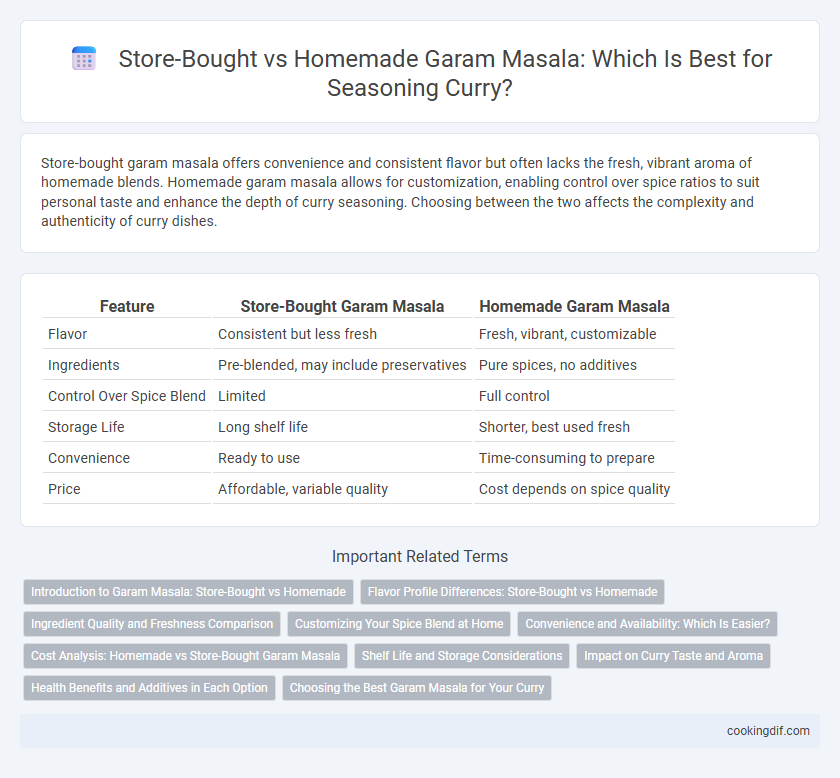Store-bought garam masala offers convenience and consistent flavor but often lacks the fresh, vibrant aroma of homemade blends. Homemade garam masala allows for customization, enabling control over spice ratios to suit personal taste and enhance the depth of curry seasoning. Choosing between the two affects the complexity and authenticity of curry dishes.
Table of Comparison
| Feature | Store-Bought Garam Masala | Homemade Garam Masala |
|---|---|---|
| Flavor | Consistent but less fresh | Fresh, vibrant, customizable |
| Ingredients | Pre-blended, may include preservatives | Pure spices, no additives |
| Control Over Spice Blend | Limited | Full control |
| Storage Life | Long shelf life | Shorter, best used fresh |
| Convenience | Ready to use | Time-consuming to prepare |
| Price | Affordable, variable quality | Cost depends on spice quality |
Introduction to Garam Masala: Store-Bought vs Homemade
Garam masala is a key spice blend in Indian cuisine, comprising aromatic spices like cinnamon, cloves, cardamom, and cumin that enhance curry flavors. Store-bought garam masala offers convenience and consistency but often lacks the freshness and personalized balance of spices found in homemade blends. Homemade garam masala allows for customization of spice ratios, delivering more vibrant aromas and richer seasoning to curry dishes.
Flavor Profile Differences: Store-Bought vs Homemade
Store-bought garam masala often lacks the vibrant aroma and complex flavor layers found in homemade blends due to pre-ground spices losing potency over time. Homemade garam masala allows control over the freshness and balance of key spices like cardamom, cinnamon, cloves, and cumin, resulting in a more robust and nuanced seasoning. The ability to toast whole spices before grinding enhances essential oils, intensifying flavor profiles that elevate curry dishes beyond the flatter notes of mass-produced variants.
Ingredient Quality and Freshness Comparison
Homemade garam masala offers superior ingredient quality and freshness compared to store-bought versions, as spices are freshly ground and blended to personal taste, preserving essential oils and vibrant flavors. Store-bought garam masala often contains pre-ground, older spices that may have lost potency and aroma due to prolonged storage and exposure to air. Choosing homemade spice blends ensures maximum flavor intensity and nutritional benefits, enhancing the seasoning quality in curry dishes.
Customizing Your Spice Blend at Home
Homemade garam masala allows for precise customization of spice ratios, tailoring the blend to individual taste preferences and recipe requirements. Freshly toasted whole spices release more intense aromas and flavors compared to pre-ground store-bought versions, enhancing curry seasoning. Adjusting ingredients like cardamom, cinnamon, cloves, and cumin in homemade blends creates a unique, vibrant profile that store-bought options often lack.
Convenience and Availability: Which Is Easier?
Store-bought garam masala offers unmatched convenience with pre-blended spices readily available in most grocery stores, saving time and effort for quick seasoning. Homemade garam masala allows customization of spice proportions, but requires sourcing fresh whole spices and grinding, which can be time-consuming and less accessible for some. For ease and consistent availability, store-bought garam masala is the simpler choice for everyday cooking.
Cost Analysis: Homemade vs Store-Bought Garam Masala
Homemade garam masala offers significant cost savings compared to store-bought versions, as bulk purchase of whole spices reduces per-use expenses over time. Store-bought garam masala typically contains pre-ground spices mixed in fixed proportions, often increasing costs due to packaging and branding. Investing in quality whole spices for homemade blends not only lowers long-term costs but also allows customization of flavor intensity and freshness.
Shelf Life and Storage Considerations
Store-bought garam masala typically has a longer shelf life than homemade blends due to commercial packaging techniques that include airtight, moisture-resistant containers and preservatives, often lasting up to two years if stored in a cool, dark place. Homemade garam masala, lacking preservatives and packaged in standard containers, usually retains optimal flavor for six months when stored in an airtight jar away from heat and light. Proper storage of both types minimizes exposure to humidity and air, which accelerates the degradation of essential oils that provide the spice's characteristic aroma and potency.
Impact on Curry Taste and Aroma
Store-bought garam masala offers convenience but often contains pre-ground spices with diminished potency, resulting in a milder curry taste and less vibrant aroma. Homemade garam masala allows precise control over fresh whole spices, enhancing the curry's complexity, depth, and aromatic intensity. Using freshly toasted and ground spices in homemade blends maximizes essential oils, delivering a richer sensory experience in the final dish.
Health Benefits and Additives in Each Option
Store-bought garam masala often contains preservatives, anti-caking agents, and added salts that may reduce its health benefits compared to homemade blends. Homemade garam masala allows for control over ingredient quality, ensuring fresh spices like cinnamon, cardamom, and cloves, which are rich in antioxidants and anti-inflammatory compounds. Choosing homemade garam masala minimizes exposure to synthetic additives, promoting a cleaner seasoning option with enhanced nutritional value.
Choosing the Best Garam Masala for Your Curry
Store-bought garam masala offers convenience and consistency with a balanced blend of spices like cumin, coriander, cinnamon, and cardamom, making it ideal for quick curry preparations. Homemade garam masala allows customization of spice ratios and freshness, enhancing the depth and aroma tailored to specific curry recipes or personal preferences. Selecting the best garam masala depends on the desired flavor intensity, freshness, and control over ingredients to elevate your curry seasoning effectively.
Store-bought garam masala vs homemade garam masala for seasoning Infographic

 cookingdif.com
cookingdif.com